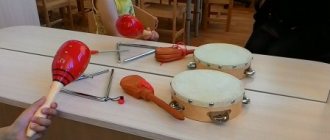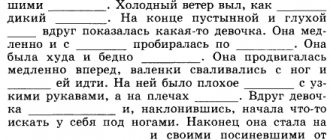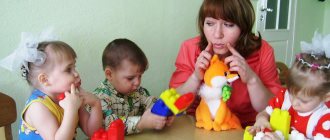Phonemic awareness is like a door that opens the speech flow in a child's development. This type of perception ensures the formation of the ability to understand speech by ear. He is also responsible for the gradual transformation of baby babble into meaningful words and sentences. The development of phonemic awareness in preschoolers depends on the characteristics of other cognitive processes. Thus, children with tenacious attention begin to recognize speech sounds faster. This process is accompanied by greater accuracy, which contributes to the development of phonemic hearing.
What is phonemic awareness?
When a baby learns to speak and understand speech addressed to him, development occurs in two areas - the pronunciation side of speech and the recognition and analysis of speech. In preschool centers, great attention is paid to both areas. Analysis of sound content, in turn, involves hearing and perception.
- Phonemic hearing
is the innate ability to hear and distinguish units of speech. - Phonemic perception
is the ability to distinguish meaningful units of language (phonemes) and understand the sound composition of the native language.
This is a necessary condition for the formation of beautiful coherent speech, clear pronunciation, learning to read and write, which are necessary not only in everyday life, but also in acting schools and vocal classes.
Article:
CORRECTIONAL WORK:
1) DEVELOPMENT OF AUDITORY ATTENTION; 2) FORMATION OF PHONEMATIC HEARING
Corrective work on the formation of FS with children suffering from speech disorders is built in two stages:
1) development of auditory attention; 2) formation of the FS.
1. Development of auditory attention to non-speech sounds at the preparatory stage.
Distinguishing non-speech sounds: loud - quiet, long (long) - short, high - low, pleasant (kind, affectionate} - unpleasant (angry, rude).
Exercises and games to develop auditory attention: [2]
- “What sounds break the silence?”
- “Who will hear more sounds?”,
- “Name the sounds of a group room,”
- “Name the sounds of the street”
- “Remember the sounds of the forest, meadows, swamps,”
- “Find a box of cereal that sounds the same,”
- “Blind Man's Bluff with a Bell”
- “Ladushki”,
- “Morse code”,
- “Whose voice?”
- "Sun or Rain"
- “Guess by the sound what to do?”,
- The sound of musical instruments.
- Songs of insects.
- Voices of animals, birds.
- Sounds of transport.
- Sounds of working tools.
2. Formation of phonemic hearing throughout all stages of correctional work.
The first stage is recognition of non-speech sounds.
Distinguishing non-speech sounds by ear is the foundation and basis for the development of phonemic hearing.
- Game "Guess what sounded." Listen carefully with your child to the sound of water, the rustle of a newspaper, the clinking of spoons, the creaking of a door and other everyday sounds. Invite your child to close his eyes and guess what it sounded like.
- Game "Noisy bags". Together with your baby, pour cereal, buttons, paper clips, etc. into bags or boxes. The child must guess by the sound of the shaking bag what is inside.
- Game "Magic Wand". Taking a pencil or stick for any purpose, tap it on different objects in the house. A magic wand will make a vase, table, wall, bowl sound...
Then complicate the task - the child guesses with his eyes closed which object sounded.
- Game "Blind Man's Bluff". The child is blindfolded and moves towards the ringing bell, tambourine, or whistle.
- Game "Let's Clap" The child repeats the rhythmic clapping pattern. For example, two claps, pause, one clap, pause, two claps. In a more complicated version, the baby repeats the rhythm with his eyes closed.
The second stage is distinguishing speech sounds by timbre, strength and pitch.
- Game "Find out your voice." Record on tape the voices of loved ones and the voice of the child himself. Ask him to guess who is speaking.
- Game "Loud and Quiet". Agree that your child will do certain things when you say words loudly and when you say them quietly. There is a similar version of the game “Far and Close”. You say the word loudly, the child answers - close. Say the word quietly, the child answers - far away.
- Game "Three Bears". The child guesses which character in the fairy tale the adult speaks for. A more complex option: the child himself speaks for the three bears, changing the pitch of his voice.
The third stage is distinguishing words that sound similar.
- Game "Listen and choose". In front of the child are pictures with similar-sounding words (com, catfish, crowbar, house). The adult names the object, and the child picks up the corresponding picture.
- Game "True or False". The adult shows the child a picture and names the object, replacing the first letter (forota, korota, morota, gate, porota, horota). The child's task is to clap his hands when he hears the correct pronunciation.
The fourth stage is syllable discrimination.
- Game "Let's Clap" The adult explains to the child that there are short and long words. He pronounces them, separating the syllables intonationally. Together with the child he pronounces words (pa-pa, lo-pa-ta, ba-le-ri-na), clapping the syllables. A more difficult option: invite the child to independently clap the number of syllables in a word.
- Game "What's extra?" An adult pronounces a series of syllables “pa-pa-pa-ba-pa”, “fa-fa-wa-fa-fa”... The child must clap when he hears an extra (different) syllable.
The fifth stage is distinguishing sounds.
Explain to your child that words are made up of sounds. Play sounds. The mosquito says - zzzz, the wind blows - ssss, the beetle buzzes - zzzzh, the tiger growls - rrrrr...
The adult makes a sound, and the child guesses who (what) makes it.
- Game "Let's Clap" The adult pronounces a series of sounds, and the child claps his hands when he hears a given phoneme.
While observing the children’s activities, I paid attention to the following indicators:
- the ability of children to hear mistakes in someone else’s, their own speech and correct them;
- the ability to distinguish sounds in words, syllables and in rows of sounds;
- practice the skill of distinguishing phonemes by ear according to acoustic features (primarily deaf - voiced, whistling - hissing, hard - soft, etc.);
— formation of a full-fledged sound aspect of speech (education of articulation skills, correct sound pronunciation, reproduction of syllabic structure)
Work on the development of phonemic awareness is carried out in the following sequence:
1. Acquaintance with an isolated sound associated with a specific image (in stories). 2. Distinguishing isolated sounds associated with a specific image. 3. Distinguishing sounds in a word. 4. Determining the place of a sound in a word (at the beginning, in the middle, at the end of the word). 5. Distinguishing by ear in words sounds that are similar in sound or articulation (whistles - hissing, voiced - voiceless, R - L , etc.). 6. Coming up with words for a certain sound.
Games with sounds.
- “Clap if you hear the sound [A] in the word” (we highlight the sound with our voice, “click” on it). You need to start with vowel sounds, then sonorous sounds [M], [N], [R]
- “Three words” I will say 3 words, and you name the sound that is found in all these words (duck, ears, dinner). First, the sound is released from the beginning of the word, then from the end (cinema, coat, window), then from the middle (cheese, smoke, soap).
- “Travel around the room” The winner is the one who finds the most objects denoted by words with a certain sound. (In another version of this game, each player has 4 chips of a certain color. Having found an object denoted by a word with a specified sound, the player places a chip. The winner is the one who puts all his chips first). At the end of the game there is a check. An adult can sometimes deliberately make a mistake so that the child will later check each word with interest, listening to it carefully.
- First, we teach children to hear, distinguish and identify the first sound in one word (d/i “Identify the first sound”), then the first and last sounds in a number of words (game “Chain of Words”).
- Next, they determine any position of the sound in the word: at the beginning, in the middle or at the end (game exercise “Find the place of the sound in the word”). In addition, older preschoolers practice selecting words with a certain sound ( games “Who lives in the house?”, “Collect a bouquet”), and differentiating the most complex sounds: S–SH, R–L (games “Who can collect things faster?” , "Shop").
- In the game exercise “Find a pair, ” the child, moving the arrow on the disk, learns to select words by sound: bowl - bear, mustache - wasp, lump - catfish, etc.
- Using entertaining puzzle games like “Build a Pyramid,” preschoolers are trained to determine the number of syllables and sounds in words. So, in a “flower shop” you can buy a flower if you can determine the number of syllables in its name.
- The division of words into syllables is reinforced in the game “Let's decorate the Christmas tree” (two- and three-syllable words: star-da, cotton-push-ka, etc.)
- Cardboard girl dolls (vowel sounds) and boy dolls (consonant sounds) train preschoolers from the age of four to identify the desired sound by articulation. Kids arrange pictures according to human sounds (Ana - watermelon, album, bus, etc.) Recognition and discrimination of speech sounds, syllabic division of words is formed in word games: “Echo”, “Field of Miracles”, “Living Sounds”, “ For mushrooms”, “Beat the word syllable by syllable with a ball”. The following games develop phonemic interest: “Pick a rhyme”, “Say a word”, “Inverted words”, “Additions”.
- “ Feed the Pea Man” is the name of the activity, which simultaneously promotes the development of physical skills and the development of fine motor skills. First, the child must isolate the control sound from the sound range. For example, the teacher calls “A” - the child answers “no”, “F” - “no”, “M” - “no”, “R” - “Yes.” Eat, Roma, please!” and with these words he puts one pea into the “little man’s” mouth. Then the child performs a similar task with a syllabic series and only then with a verbal one. If two control sounds are detected in one word, you must give the “little man” two peas. Children give different names to the “pea man” - depending on the control sound (Semyon, Zakhar, Misha, Zhenya, Volodya, Roma, Igor, Kostya, Gena, etc.).
- “Catch the word in your palms” (make a word from separately named sounds). Name consonant sounds without vowel overtones (D, O, M - house)!
- “The sounds are mixed up” (a variant of the previous game, but the sounds are given in a broken sequence D, M, O - house).
- “Wizards” (by replacing one sound in a word, we turn one word into another: JUICE – TOK – TOM – HOUSE – COM – SOM – SLEEP – JUICE – BITCH – KNOCK – SO – CANCER – MAC...). Another version of this game is to form new words by adding a consonant sound: ANYA - SANYA, VANYA, DANYA, MANYA, TANYA.
- “Find the word that is hidden in other words”
1) Make a word from the first sounds of the words: HAT, BUS, CANCER - BALL
2) Make up a word from the last sounds of the words: MOSQUITO, GRASS, JUICE - CANCER
3) Compose a word from the third sounds of the words: BUSH, MOLE, DOLL - JUICE You can play with pictures or without a visual basis.
- “Chain of words” (come up with a word based on the last sound of the previous word). For speech games with preschoolers, choose words in which the spelling does not differ from the pronunciation. Remember, for example, that voiced consonant sounds at the end of words are deafened: FROST, TOOTH.
- “Extra word” (out of four spoken words, choose the one that differs from the rest: NORA, NORA, TIME, NORA EAR, EAR, EAR, HAIR BRAID, GOAT, BRITATE, SCIT CAT, YEAR, CAT, CAT HONEY, HONEY, ICE , HONEY PIPE, FISHING FISHING, PIPE, PIPE
- The use of special pencil cases in sound analysis (as an effective method of developing FS) takes place in classes to prepare for mastering literacy. Six-year-olds make up a sentence, for example: “My friend Petya caught a big crucian carp on the lake.” Children put a long strip on the table and say: “This is a proposal. It starts with a capital letter. There is a period at the end of the sentence.” Then they isolate words in the sentence one by one, pointing to each short strip: My friend Petya
I caught a big crucian carp on the lake. There are eight words in this sentence.
- Next operation: dividing words into syllables (in various kinesthetic ways):
- clapping with palms,
-control with the right hand over the lowered chin,
- step-slogometry.
- Let’s choose one word, for example “lake”, and perform a sound analysis of it using the “Sound Characteristics” algorithm:
[o] - vowel sound, [z'] - consonant sound, soft, sonorous, [e] - vowel sound, [r] - consonant sound, hard, sonorous, [o] - vowel sound.
The word “o-ze-ro” has three syllables and five sounds.
- In a play situation, a clear, isolated sound is evoked using toys:
mosquito - [h], yellow beetle - [f], grasshopper - [h], snake - [w], airplane - [l], boat - [r].
- In the process of correctional work with preschoolers at the stages of automating sounds in words and sentences, toys for sounds that are complex in articulation are used:
– elephant, dog, pig, etc. – snake, goat, monkey, etc. – chicken, hen, sheep, etc. – pine cone, bear, mouse, etc. – beetle, giraffe, hedgehog, etc. – turtle, Cippolino, butterfly, grasshopper, etc. – puppy, brush, rattle, etc. – horse, fox, airplane, etc. – fish, cow, boat, Pinocchio, etc.
Such a variety of gaming didactic techniques constantly maintains the interest of children in the process of forming FS.
FORMATION OF PHONEMATIC HEARING IS THE MAIN CONDITION FOR SUCCESSFUL LITERACY TEACHING.
Graduates of the kindergarten speech group cross the school threshold with the following knowledge:
-the first word in a sentence and names are written with a capital letter;
-at the end of the sentence there is a period;
-semantic isolation of words from a phrase. Each word is written separately (important for spelling prefixed verbs (such as “wrote”, “jumps”) and nominal parts of speech with prepositions (for example: “on the lake”, “under the blue”);
-the ability to divide words into syllables will play a positive role in reflecting the syllabic structure in writing, when transferring part of a word to the next line;
- the child will not “lose” a single letter when reading and writing, because he is accustomed to highlight all sounds in a word: from the first to the last;
- phonemic perception will help the child make the right choice among mixed sounds in words like: “iron”, “highway”, “calendar”, etc.
Offer.
The first period begins with the preparatory stage a (2-3 lessons), where children are introduced to the concepts of “word” and “sentence”. They teach the simplest operations with them. In the first lesson, children are introduced to the concept of “word”. It is explained that each word has its own meaning; for this, children should be taught to distinguish words from an incoherent set of sounds. The following techniques can be used: The speech therapist pronounces either words or arbitrary combinations of sounds (for example, “krakamuk”), and the child verbally or with a certain signal notes when a word was pronounced and when a set of sounds was pronounced. The child names the words himself and comes up with pseudowords. The speech therapist pronounces words distorted, changing, for example, the order of syllables or replacing sounds (“kobolok” - bun, “hobos” - trunk), and the child restores the word and pronounces it. It is advisable to correctly pronounce the first syllable or the first sound of a word.
Second period . In the next lesson, the concept of “sentence” is given with the help of practical examples. The teacher explains that a sentence is several words that express a specific complete thought. To understand this concept, you can use the technique of comparing simple sentences with a set of words or phrases. The words in a sentence are pronounced sequentially, one after another. It is useful to conduct a didactic exercise “Living Words”, in which the child must find a place for his word in a sentence (and for himself in the order of children) and pronounce it in time. When analyzing a sentence, children should be taught to determine the number of words in a sentence. For this, various objects are used (counting sticks, strips of cardboard, matches). The speech therapist pronounces a sentence, and the children lay out the number of words using these objects. Then a conventional graphic designation of words in a sentence is introduced (straight line). A sentence always begins with a capital letter, which is also marked with a special graphic sign (corner). It is necessary to introduce children to various punctuation marks at the end of a sentence and point out the possible intonation of the sentence. Throughout the entire period of literacy training, the ability to analyze a sentence consistently, with gradual complication, develops (determine the number of words, their sequence, draw up a graphic diagram), which is reflected in the presented long-term planning: 1. a simple two-part sentence without prepositions;
2. a simple sentence of 3 words without a preposition;
3. a simple sentence of 3-4 words without a preposition;
4. a simple sentence of 3-4 words with simple prepositions;
5.sentences of 4-5 words with and without prepositions.
Why is it important to develop this in preschool?
Hearing develops naturally even before birth, and after birth it undergoes serious improvement, which is completed around 7–8 years. Psychologist Lev Vygotsky identified three speech operations that require phonemic hearing:
- the ability to determine whether a given sound is in a particular word;
- the ability to recognize and understand words consisting of the same letters arranged in different orders;
- the ability to understand words that sound similar but have different meanings.
Phonemic perception, on the contrary, is not formed spontaneously, but requires some effort on the part of the child, parents and teachers.
Violation of these functions can lead to a child falling behind the educational program in kindergarten, and then at school, and to difficulty mastering the Russian language and writing.
Most often, sound perception disorders are diagnosed during preparation for school. In this case, teachers immediately send the child to classes with a speech therapist for children 5 or more years old.
Distinguishing words that are similar in sound composition
Exercise 3 Repeat two words after an adult and determine whether they sound similar:
|
|
|
Exercise 4 Repeat after the adult, first two then three similar words in the given order:
|
|
Exercise 5 An adult clearly pronounces pairs of words and asks the child to determine whether the names he hears are the same or different:
|
|
Exercise 6
Of the four words spoken by an adult, the child must choose and name the word that is different from the rest:
- com - com - cat - com
- ditch - cocoa - ditch - ditch
- duckling - duckling - duckling - kitten
- booth - letter - booth - booth
- screw - screw - screw - bandage
- minute - coin - minute - minute
- buffet - bouquet - buffet - buffet
- Ticket - ballet - ballet - ballet
- pipe - booth - booth - booth
Exercise 7
An adult invites the child to finish the couplet by choosing a suitable rhyming word:
| I dropped the briefcase from my hands, it was so big on the branch... (beetle). A nimble bear was walking through the forest, and... (a bump) fell on him. There are evil animals here in the forest, Lock them at night... (doors). We collected cornflowers on our heads... (wreaths). And back and forth It can sail... (steamboat). | Hush, Tanechka, don’t cry, Don’t drown in the river... (ball). One evening two mice took Petya away... (books). Vlad doesn’t crawl onto the spruce tree. In his hands... (briefcase). The dog brought a bouquet to the goat, It will be filling for her... (lunch). Don’t tremble, Seryozhka, this is ours... (cat). |
Exercises to improve auditory perception in children
Recognition of non-speech sounds.
This is a play practice that can be done at home, on a walk, in a children's club or in any other setting. Ask your child to listen and answer: what is the noise outside the window? How many phonemes can he distinguish? What produces them? Similarly, you can play at home using musical instruments or recording their sounds.
Pitch
. In this activity, children are taught to distinguish the tone of sounds made. There are many exercise options. For example, play a recording of a children's fairy tale about “The Three Bears” and ask the child to answer which voice belongs to daddy bear, which voice belongs to mother, which voice belongs to the baby.
Similar Word Recognition
. It is important to teach a preschooler not to confuse similar words and to pronounce them correctly, without replacing letters with similar ones. This is an exercise that is used in early development centers and courses for children: show your child a picture and say the name of what is drawn on it, replacing only the first letter. The child’s task, upon hearing the correct pronunciation of the word, is to clap his hands and stop the adult.
Sounds and colors.
Give your preschooler 3-5 cards of different colors. Explain in advance that each color has a corresponding sound. For example, green - A, yellow - U, etc. The child should pick up the card of the corresponding color when they hear a specific sound.
The formation of speech and hearing skills is a responsible and important process, so it is worth entrusting it to professionals. The Center for Additional Education for Children "Imena Production" employs highly qualified speech therapists who will not only correct speech defects in preschoolers and schoolchildren, but also help improve speech and hearing for classes in a children's vocal studio.
Syllable differentiation
Exercise 8 Repeat the syllable series after the adult, changing the stressed syllable:
|
|
|
Work with syllable rows is carried out in a similar way:
|
|
Exercise 9 Repeat after an adult syllable combinations with a common consonant and different vowel sounds:
|
|
|
Exercise 10 Repeat after an adult syllable combinations with a common vowel and different consonants:
|
|
Then syllable combinations with the vowels O, U, Y are pronounced. Exercise 11 Repeat after an adult syllable combinations with consonant sounds that differ in deafness and voicedness:
|
|
|
Then syllable combinations with the vowels O, U, Y are pronounced. Exercise 12 Repeat after an adult syllable combinations with consonant sounds that differ in hardness and softness:
|
|
|
|
|
|
|
|
Exercise 13 Repeat after the adult syllable pairs with increasing one consonant sound (to form a confluence):
|
|
Then syllable combinations with the vowels O, U, Y are pronounced. Exercise 14 Repeat after an adult syllable combinations with a common combination of two consonants and different vowels:
|
|
Exercise 15 Repeat after the adult the syllable pairs with a change of consonant sounds in their combination:
|
|
|











